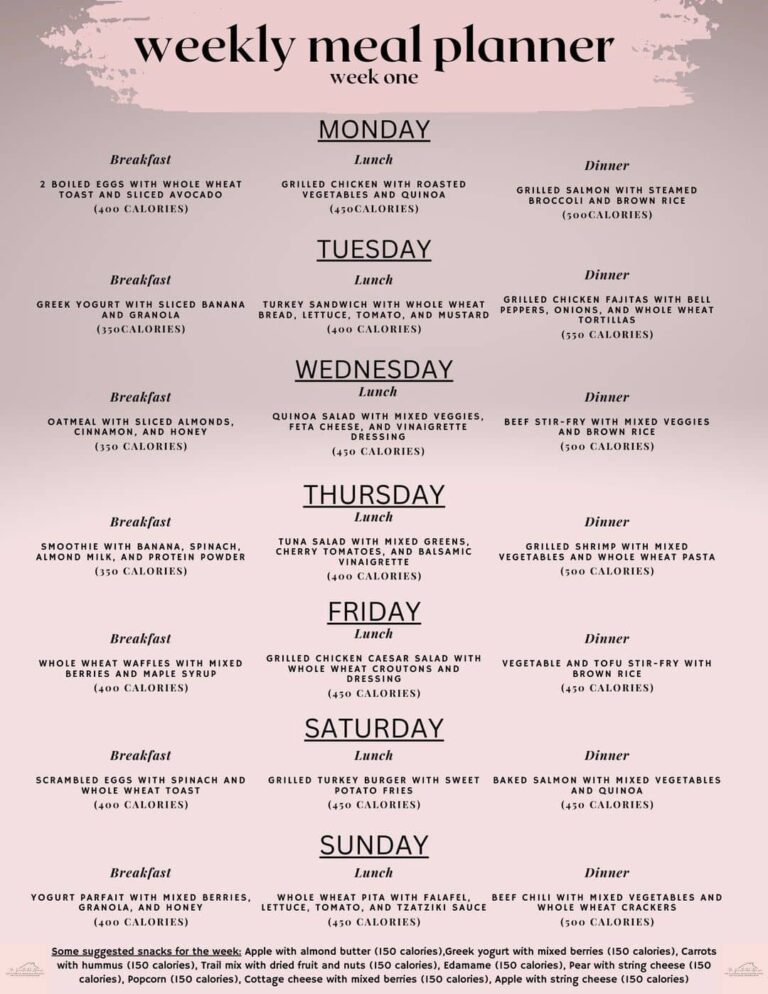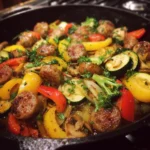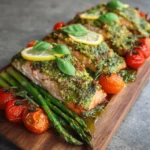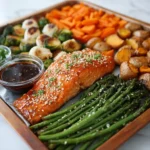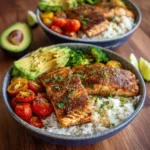Maintaining a Healthy Diet with a Detailed Weekly Meal Plan
Maintaining a healthy diet can be challenging, especially when juggling a busy schedule. However, a well-structured meal plan can be a game-changer, helping you stay on track with your nutritional goals while managing your calorie intake. This article provides a comprehensive weekly meal planner, complete with breakfast, lunch, dinner, and snack ideas. Whether your goal is to lose weight, build muscle, or simply adopt a healthier lifestyle, this guide is designed to support your journey.
Why Meal Planning is Important
Meal planning is more than just a tool for organizing your meals—it’s a strategy for achieving long-term health and wellness. Here are some of the key benefits:
- Saves Time: Preparing meals in advance reduces the time spent cooking daily. By dedicating a few hours each week to meal prep, you can streamline your routine and avoid last-minute scrambling.
- Saves Money: Planning your meals helps you avoid impulse purchases and reduces food waste. By buying only what you need, you can stick to your budget while minimizing unnecessary expenses.
- Promotes Healthy Eating: Having a plan in place makes it easier to stick to nutritious meals. When healthy options are readily available, you’re less likely to reach for unhealthy snacks or fast food.
- Reduces Stress: Knowing what you’ll eat each day eliminates the daily decision-making process. This can reduce mental fatigue and help you stay focused on your goals.
- Supports Portion Control: Meal planning allows you to portion your meals appropriately, ensuring you don’t overeat or consume too few calories.
Week One Meal Plan
Monday
Breakfast:
- 2 Boiled Eggs with Whole Wheat Toast and Sliced Avocado (400 Calories)
- Tips: Use whole-grain bread for added fiber. Avocado provides healthy fats.
Lunch:
- Grilled Chicken with Roasted Vegetables and Quinoa (450 Calories)
- Tips: Season chicken with herbs and spices. Roast a mix of vegetables like bell peppers, zucchini, and carrots.
Dinner:
- Grilled Salmon with Steamed Broccoli and Brown Rice (300 Calories)
- Tips: Grill salmon with a drizzle of olive oil and lemon. Steam broccoli to retain nutrients.
Tuesday
Breakfast:
- Greek Yogurt with Sliced Banana and Granola (350 Calories)
- Tips: Choose plain Greek yogurt to avoid added sugars. Add a handful of nuts for extra protein.
Lunch:
- Turkey Sandwich with Whole Wheat Bread, Lettuce, Tomato, and Mustard (400 Calories)
- Tips: Use lean turkey breast and whole-grain bread. Add avocado for healthy fats.
Dinner:
- Grilled Chicken Fajitas with Bell Peppers, Onions, and Whole Wheat Tortillas (500 Calories)
- Tips: Marinate chicken in lime juice and spices. Serve with a side of salsa or guacamole.
Wednesday
Breakfast:
- Oatmeal with Sliced Almonds, Cinnamon, and Honey (350 Calories)
- Tips: Use rolled oats for a hearty texture. Add fresh fruit for natural sweetness.
Lunch:
- Quinoa Salad with Mixed Veggies, Feta Cheese, and Vinaigrette Dressing (450 Calories)
- Tips: Mix quinoa with chopped vegetables like cucumbers, tomatoes, and bell peppers. Add a sprinkle of feta for flavor.
Dinner:
- Beef Stir-Fry with Mixed Veggies and Brown Rice (500 Calories)
- Tips: Use lean beef and a variety of vegetables. Stir-fry with a light soy sauce or teriyaki sauce.
Thursday
Breakfast:
- Smoothie with Banana, Spinach, Almond Milk, and Protein Powder (350 Calories)
- Tips: Blend until smooth. Add a tablespoon of chia seeds for extra fiber.
Lunch:
- Tuna Salad with Mixed Greens, Cherry Tomatoes, and Balsamic Vinaigrette (400 Calories)
- Tips: Use canned tuna in water. Mix with greens and a light dressing.
Dinner:
- Grilled Shrimp with Mixed Vegetables and Whole Wheat Pasta (500 Calories)
- Tips: Grill shrimp with garlic and olive oil. Serve over whole wheat pasta with a side of steamed vegetables.
Friday
Breakfast:
- Whole Wheat Waffles with Mixed Berries and Maple Syrup (400 Calories)
- Tips: Use whole-grain waffles. Top with fresh berries and a drizzle of maple syrup.
Lunch:
- Grilled Chicken Caesar Salad with Whole Wheat Croutons and Dressing (450 Calories)
- Tips: Use a light Caesar dressing. Add whole-grain croutons for crunch.
Dinner:
- Vegetable and Tofu Stir-Fry with Brown Rice (450 Calories)
- Tips: Stir-fry tofu with a mix of vegetables. Use a light soy sauce or teriyaki sauce.
Saturday
Breakfast:
- Scrambled Eggs with Spinach and Whole Wheat Toast (400 Calories)
- Tips: Add spinach to scrambled eggs for extra nutrients. Serve with whole-grain toast.
Lunch:
- Grilled Turkey Burger with Sweet Potato Fries (450 Calories)
- Tips: Use lean turkey breast. Bake sweet potato fries with a light coating of olive oil.
Dinner:
- Baked Salmon with Mixed Vegetables and Quinoa (450 Calories)
- Tips: Bake salmon with a drizzle of olive oil and lemon. Serve with a side of quinoa and steamed vegetables.
Sunday
Breakfast:
- Yogurt Parfait with Mixed Berries, Granola, and Honey (400 Calories)
- Tips: Layer Greek yogurt with fresh berries and granola. Drizzle with honey for sweetness.
Lunch:
- Whole Wheat Pita with Falafel, Lettuce, Tomato, and Tzatziki Sauce (450 Calories)
- Tips: Use whole-grain pita. Add falafel and fresh vegetables. Serve with a light tzatziki sauce.
Dinner:
- Beef Chili with Mixed Vegetables and Whole Wheat Crackers (500 Calories)
- Tips: Make chili with lean ground beef and a variety of beans. Serve with whole-grain crackers.
Suggested Snacks for the Week
- Apple with Almond Butter (150 Calories)
- Greek Yogurt with Mixed Berries (150 Calories)
- Carrots with Hummus (150 Calories)
- Trail Mix with Dried Fruit and Nuts (150 Calories)
- Edamame (150 Calories)
- Pear with String Cheese (150 Calories)
- Popcorn (150 Calories)
- Cottage Cheese with Mixed Berries (150 Calories)
- Apple with String Cheese (150 Calories)
Tips for Successful Meal Planning
- Prepare in Advance: Spend some time each week planning and prepping your meals.
- Shop Smart: Make a grocery list based on your meal plan to avoid impulse buys.
- Cook in Bulk: Prepare large batches of meals that can be eaten throughout the week.
- Stay Flexible: Be open to swapping meals based on your schedule and preferences.
- Stay Hydrated: Drink plenty of water throughout the day to support digestion and overall health.
Conclusion
A well-structured meal plan can make a significant difference in your health and well-being. By following this weekly meal planner, you can enjoy a variety of nutritious and delicious meals while staying within your calorie goals. Remember, consistency is key, and with time, meal planning will become a seamless part of your routine.
